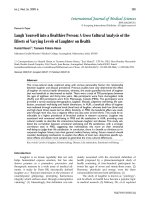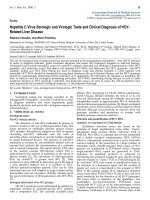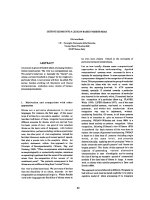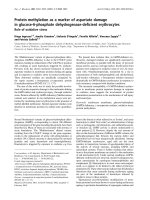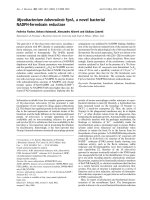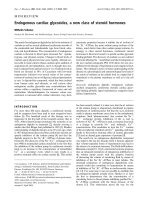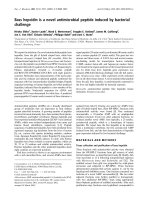Báo cáo y học: " Laugh Yourself into a Healthier Person: A Cross Cultural Analysis of the Effects of Varying Levels of Laughter on Health"
Bạn đang xem bản rút gọn của tài liệu. Xem và tải ngay bản đầy đủ của tài liệu tại đây (438.93 KB, 12 trang )
Int. J. Med. Sci. 2009, 6
200
I
I
n
n
t
t
e
e
r
r
n
n
a
a
t
t
i
i
o
o
n
n
a
a
l
l
J
J
o
o
u
u
r
r
n
n
a
a
l
l
o
o
f
f
M
M
e
e
d
d
i
i
c
c
a
a
l
l
S
S
c
c
i
i
e
e
n
n
c
c
e
e
s
s
2009; 6(4):200-211
© Ivyspring International Publisher. All rights reserved
Research Paper
Laugh Yourself into a Healthier Person: A Cross Cultural Analysis of the
Effects of Varying Levels of Laughter on Health
Hunaid Hasan
, Tasneem Fatema Hasan
Mahatma Gandhi Mission’s Medical College, Aurangabad, Maharastra, India, 431003
Correspondence to: Hunaid Hasan or Tasneem Fatema Hasan, “Ezzi Manzil”, CTS No. 3910, Near Bombay Mercantile
Bank, Beside Amodi Complex, City Chowk, Juna Bazaar, Aurangabad, Maharashtra, India 431001. Email:
or Phone: +91-240-234-8673/ +91-982-390-5866/ +1-905-826-3752.
Received: 2009.05.01; Accepted: 2009.07.17; Published: 2009.07.28
Abstract
This cross-cultural study explored along with various personality factors the relationship
between laughter and disease prevalence. Previous studies have only determined the effect
of laughter on various health dimensions, whereas, this study quantified the level of laughter
that was beneficial or detrimental to health. There were a total of 730 participants between
the ages of eighteen and thirty-nine years. 366 participants were from Aurangabad, India
(AUR), and 364 participants were from Mississauga, Canada (MISS). The participants were
provided a survey assessing demographics, laughter, lifestyle, subjective well-being, life satis-
faction, emotional well-being and health dimensions. In AUR, a beneficial effect of laughter
was mediated through moderate levels (level two) of laughter, whereas both low (level one)
and high (level three) levels had no effect. Similarly, in MISS, the beneficial effect was medi-
ated through level two, but a negative effect was also seen at level three. This could be at-
tributable to a higher prevalence of bronchial asthma in western countries. Laughter was
associated with emotional well-being in MISS and life satisfaction in AUR, providing cross
cultural models to describe the interactions between laughter and disease. This study vali-
dated the correlation between emotional well-being and life satisfaction, with a stronger
correlation seen in MISS, suggesting that individualists rely more on their emotional
well-being to judge their life satisfaction. In conclusion, there is a benefit to clinicians to in-
corporate laughter history into their general medical history taking. Future research should
consider developing mechanisms to explain the effects of level two, determine specific sys-
temic effects and obtain more samples to generalize the cross cultural differences.
Key words: Levels of laughter, History-taking, Disease, Life satisfaction, Emotional well-being
Introduction
Laughter is an innate capability that not only
helps humankind express emotion, but has also
shown promise as a promotive, preventive and
therapeutic measure to a wide array of medical ail-
ments. A study by Parse RR, structurally defined
laughter as a “buoyant immersion in the presence of
unanticipated glimpsings prompting harmonious
integrity which surfaces anew through contemplative
visioning”. (1) Interestingly, this definition was inti-
mately associated with the structural definition of
health proposed by a phenomenological study of
health consisting of four-hundred participants be-
tween the ages of seven and ninety-three years. (2)
Harmony, plenitude and energy were the three
commonalities between both definitions. (1)
The study of laughter is known as “gelatology”,
and its effects on health have become a popular topic
in medical research. (3) Mahony, DL, et al. explored
Int. J. Med. Sci. 2009, 6
201
various types of laughter that were thought to be
health-promotive. (4) The younger age group pre-
sumed laughter to be “strong, active, inhibited and
loud”, whereas the elderly (mean age difference of 60
years) believed laughter should be “gentler, kinder,
and less active” for its benefit on health. Commonly,
both groups, more importantly the elderly, found
positive emotion to influence their laughter.
Neurophysioanatomy of Laughter
The neuro-anatomical pathway for laughter has
finally been understood after twenty years of re-
search. A single centre located in the dorsal upper
pons controls two pathways, the “voluntary path”
and the “involuntary path” otherwise known as the
“emotionally-driven path”. (5) The voluntary path-
way begins from the premotor opercular areas and
travels via the motor cortex and pyramidal tract to the
ventral brain stem. The involuntary path is comprised
of amygdala, thalamic, hypothalamic, and subtha-
lamic areas, in addition to the dorsal brain stem.
Moreover, the Society for Neurosciences has grouped
the neuronal control of laughter into three compo-
nents: cognitive area, motor area and emotional area.
The cognitive area, or the frontal cortex, comprehends
various stimuli. The motor area, identified as the
supplemental motor cortex, generates a series of
muscle movements needed for producing facial ex-
pression during laughter. Finally, the emotional area,
mainly the nucleus accumbens perceives and ration-
alizes happiness. (6)
Effects on Health [Cardiovascular System (CVS), Central
Nervous System (CNS) Immunological System (IS), Res-
piratory System (RS)]
Kataria M, at the School of Laughter Yoga, de-
scribed laughter as a “powerful form of exercise that
gives you more of a cardiovascular workout than
many ‘regular’ aerobic activities. (7) Similarly, two
stages of laughter have been described, the arousal
phase, elevating the heart rate, and the resolution
phase, resting of the heart. (8) Cardiologists at the
University of Maryland found those patients who
were suffering from myocardial infarction (MI) were
40% less likely to laugh. However, laughter was
shown to be prophylactic against MI. Furthermore, an
article by Miller M, et al. at the University of Mary-
land found beneficial effects of laughter on the blood
vessel. This study consisted of twenty volunteers,
where two video clips from both extremes of the
emotional spectrum were shown. At the end of the
videos, the brachial artery constricted for five minutes
and was then released. In fourteen of the twenty
volunteers the artery constricted after watching the
stress stimuli, and dilated in nineteen of the twenty
volunteers after watching the laughter stimuli.
Moreover, the release of nitric oxide is considered
vital for vasodilatation. Mental stress was shown to
degrade nitric oxide, and therefore, laughter mini-
mized the negative effects of stress by reducing the
break down of nitric oxide and thus, leading to vaso-
dilatation. (9) On average, laughter increased blood
flow by twenty-two percent, and stress decreased
blood flow by thirty-five percent. (10)
Immunity is a form of integral protection and
defense against foreign agents. Laughter had shown
to affect the release of various immune mediators.
(11,12,13,14,15) Psychoneuroimmunological studies
demonstrated connections between the brain and the
immune system, such as the hypotha-
lamic-pituitary-adrenal (HPA) axis and neural supply
of lymphoid tissues. (16) In a study performed by
Berk LS, et al., they found increased blood levels of
interferon-gamma in ten healthy fasting males after
being shown a comedy video (p=0.02). (16) As a re-
sult, interferons have become a line of pharmaco-
therapy in viral infections, systemic carcinomas,
hepatitis B and C, in addition to the development of
antiretroviral drugs.
There are two types of stress: distress (the nega-
tive type), and eustress (the positive type also known
as mirthful laughter). Distress was shown to increase
stress hormones such as beta-endorphins, corticotro-
phins and catecholamines, but laughter (a form eus-
tress) decreased these hormones, fortified activity of
natural killer (NK) cells, activated T cells and B cells
and increased Ig levels. Thus, laughter is capable of
combating the negative aspects of distress and forti-
fying the individual’s immune system to help fight
against various immune mediated illnesses.
(11,12,13,14)
Liangas G, et al. associated the detrimental ef-
fects of laughter with bronchial asthma. (17) Bronchial
asthma can be triggered by: allergic reactions, various
pharmacological agents, the environment, occupation,
infections, exercise and emotions. Laughter is com-
posed of both a physical (exercise) and emotional
component. Perhaps, laughter, as a form of exercise
and as an emotional response triggers bronchial
asthma, and thus a potent stimulus. Specifically, the
physical aspect (exercise) of laughter was considered
to cause exercise associated bronchial asthma which is
prevalent at a later age. (18,19, 20) According to Gay-
rard P, 52.4% of 143 asthmatics stated their attacks of
bronchial asthma were induced by laughing. (18) It
was suggested, hyperventilation might be a cause to
laughter-associated-asthma, in addition to stimulation
of irritant receptors in the airway epithelium. (17) The
Int. J. Med. Sci. 2009, 6
202
second mechanism being the prevalent one admixed
with the mechanism of hyperventilation seemed to
appropriately describe laughter-associated-asthma.
The World Health Organization defined health
as a “state of physical, mental and social well-being
and not merely the absence of disease or bodily in-
firmity,” and provided a holistic approach in assess-
ing health. (21) An article by Richman J, offered in-
sight into laughter and its role in mental and social
health, both of which influenced each other in nu-
merous ways. (22) Furthermore, humans are social
animals (23), and their state of mental health is influ-
enced by various interactions in society.
Aims and Objectives
This study examined the relationship between
various dimensions of personality, levels of laughter
and their effects on disease. Previous research has
approached laughter more experimentally. However,
this article focuses on bringing a systematic approach
by incorporating various dimensions of personality to
broaden the understanding of laughter and its appli-
cation in clinical practice. Therefore, the ultimate ob-
jective was to determine whether laughter history
should be included as a part of routine medical his-
tory taking, and if whether questions related to an
individuals’ level of daily laughter should be incor-
porated into a medical history to facilitate diagnosis,
prognosis and management of various medical con-
ditions.
Methods
The study was approved by the ethics board of
research at Mahatma Gandhi Mission’s (MGM)
Medical College, Aurangabad (AUR).
Participants
A total of 730 young individuals between the
ages of eighteen to thirty-nine were surveyed. (24)
This age group was selected to control for health
conditions as a direct result of aging process.
Two culturally distinct samples were surveyed.
The first sample was from Mississauga (MISS), Can-
ada representing an individualistic society, and the
second sample from Aurangabad (AUR), India rep-
resenting a collectivist society. Markus HR, et al. de-
fined individualism as “an independent view of the
self and an entity that is distinct, autonomous,
self-contained, and endowed with unique disposi-
tions”. On the other hand, they also described a col-
lectivist culture as an “interdependent view of the self
as part of a larger social network, which includes
one’s family, co-workers and others to whom we are
socially connected”. (25) Furthermore, Triandis HC,
provided three criteria that would help distinguish an
individualistic society from a collectivistic one. (26)
The three criteria are: complexity, affluence and het-
erogeneity of society. Most important to consider is
“heterogeneity of society”. Mississauga is an ethni-
cally diverse society where two or more cultures co-
exist, this is considered to be heterogeneous in its
composition, which is by nature more liberal and al-
lows for individual expression. (27) Therefore, the
crux of individualism is the ethnic diversity of various
individuals. It is not the particular view of the indi-
vidual that makes them an individualist, but it is the
differing views of a group of individuals that makes
an individualist society. Conversely, Aurangabad is
homogenous in its local dialect (Marathi), and
socio-cultural environment for which it is considered
collectivistic. The first sample, from MISS, was com-
prised of 364 participants. The participants included
teachers and students from Rick Hansen Secondary
School, and employees of local retail shops (Coast
Mountain Sports, Mexx, Fairweather, Adidas, Living
Den, Fruits & Passion, Tommy Hilfiger, Nutrition
House, Benix, Grand & Toy, Purdy’s, Randy River,
Bell World and Coles) and GlaxoSmithKline Inc.
(Departments: Solid Dose Manufacturing, Validation
and Regulatory Operations). Moreover,
post-secondary students were surveyed through an
online survey website, Survey Monkey. The online
survey (
=tTYWdl431H8mcvtwvQIwuw_3d_3d) was pre-
sented in the same format as the hardcopy to ensure
uniformity of results. The email was sent to the pro-
spective participants via a message (Subject: Tell us
about your laughter). The various locations from where
the surveys were obtained ensured heterogeneity of
the participant’s cultural views, therefore represent-
ing a sample of an individualistic society. The second
sample, from AUR, was comprised of 366 individuals.
The participants included teachers and students at
MGM affiliated colleges (MGM Medical College,
Jawaral Nehru Engineering College, MGM’s Institute
of Biosciences and Technology College of Agricultural
Biotechnology and MGM’s Sangeet Academy) and
employees of various retail shops (United Colours of
Benetton, Cut, Accord Computers (P) Ltd. Computer
Mall, Reebok Shopee, The Mobile Store, Planet Fash-
ion Van Heusen, Levi’s Store, Cotton King (P) Ltd.,
Pepe London and Catmoss Retail Ltd).
As a participant, English literacy was a mini-
mum criterion. An English language based survey
conferred that participants fully understood the ques-
tions and completed the survey on their own without
assistance. This helped reduce differences between
the adult literacy in MISS (literacy rate of 99.0%) and
AUR (literacy rate of 61.0%). (28)
Int. J. Med. Sci. 2009, 6
203
Before administering the surveys, a letter pro-
viding institutional affiliation, purpose of the study
and declaration of anonymity and confidentiality was
presented to all participants. After completing the
survey participants were given a briefing about the
study. Any incomplete surveys of the relevant infor-
mation were discarded.
Survey
The survey consisted of thirty-two questions, ti-
tled: Self-Report: Laughter and Health. It obtained details
about the participant’s demographics, laughter, life-
style, and subjective well being consisting of life sat-
isfaction and emotional well being, and an assessment
of health dimensions.
Components of the Survey
Demographics
Demographics pertaining to age, gender, city of
residence, annual income, and education were in-
cluded. Specifically, age, gender and city of residence
defined the parameters of the samples.
Measurement of Laughter
Laughter was assessed by two questions,
Laughter Q1 and Laughter Q2.
Laughter Q1. How many times do you laugh in
one day? 1. 0-5 times; 2. 6-10 times; 3. 11-15 times; 4.
16-20 times; 5. 21-25 times; 6. 25 laughs and more
Participants were to reflect upon their laughter
history before providing their answer. It was difficult
to remember an accurate number of laughs; therefore,
in attempt to reduce the error in judgement, the
numbers of laughs were grouped into six ranges.
These ranges categorized individuals into low, mod-
erate and high levels of laughter, namely, level one,
level two and level three respectively. Furthermore,
the human mind consists of two elements: the con-
scious and unconscious. The conscious mind explic-
itly assesses situations, whereas the unconscious mind
remains implicit. (29) Thus, this question expected a
conscious appraisal of the participant’s level of
laughter, but, the nature of the question evoked an
unconscious response.
Laughter Q2, referred to as situational laughter,
measured laughter in the following scenarios:
1. When the individual hears a joke
2. When the individual watches a comedy
3. When the individual is with family/relatives
4. When the individual is with friends
5. During the individual’s regular day
For each situation, the participant was required
to rate their level of laughter on a scale of one (don’t
laugh) to ten (uncontrollable laughter). This question
represented the common daily scenarios in which an
individual would most likely laugh. This scale re-
quired a conscious appraisal of the participant’s level
of laughter and expected to be less influenced by the
unconscious mind and memory biases.
Three levels of laughter categorized the partici-
pants into low, moderate and high. Laughter Q1 con-
sisted of six ranges from which they were grouped
into three levels: level one (range one and two or 0-10
laughs), level two (range three, four and five or 11-25
laughs) and level three (range six or 25 laughs and
more). Likewise, in situational laughter, Laughter Q2
consisted of a scale from one to ten and was divided
into three levels, level one (1-3), level two (4-7) and
level three (8-10).
Both methods of measurement were equally
important to validate the results of laughter. Three
different sets of responses were encountered. Firstly,
responses to both questions corresponded to the same
level of laughter, and thus, it was accepted. Secondly,
for instance if a response belonged on the two extreme
levels of laughter, like the response to Laughter Q1
was level one and the response to Laughter Q2 was
level three or vice versa, an average was taken, and
level two, was accepted. Finally, if responses be-
longed to adjacent groups such that, the response to
Laughter Q1 was level two, and the response to
Laughter Q2 was level three, the authors accepted
level three as the response, because they gave situ-
ational laughter precedence in this situation while
accepting the appropriate level of laughter.
Lifestyle
Questions concerning lifestyle were included to
explore the various other factors that influence health.
The section on lifestyle contained seven questions.
The first five questions were related to general life-
style.
Lifestyle Q1. How aware are you about your
health? (lowest) 1---10 (highest)
Participants were made to cognitively
self-evaluate and perceive their own level of aware-
ness for their health.
Lifestyle Q2. How socially active are you? (low-
est) 1---10 (highest)
Lifestyle Q3. How active are you in your com-
munity? (lowest) 1---10 (highest)
In reference to Q2 and Q3, Aristotelian Darwin-
ian’s viewed human beings as social animals by na-
ture. (23) Since humans are innately programmed to
be social, it was therefore vital to assess the partici-
pant’s social and communal involvement.
Lifestyle Q4.How physically active are you dur-
ing the day? (highest score) Active with Daily Exercise
Int. J. Med. Sci. 2009, 6
204
--- Not active (score of zero)
The response was two-fold, comprising of an
objective and subjective component. Whether they
were active or not, was subjective, and how frequently
they exercised, was objective.
Lifestyle Q5. How aware are you about your
daily diet? (highest score) I am well aware and I eat a
well balanced diet --- I am not aware and don’t eat a
well balanced diet (score of zero)
The response was two-fold, comprising of an
objective and subjective component. The awareness
about their diet was subjective, and whether they ate a
well balanced diet was objective.
These five questions were amalgamated to form
an overall score for lifestyle. The total score was
thirty-seven. Lifestyle Q1 to Lifestyle Q3 were equally
weighted and represented 81% of the total value of
the questions, whereas, Lifestyle Q4 and Lifestyle Q5
represented only 19%. This gave an appropriate level
of emphasis on Lifestyle Q4 and Lifestyle Q5, without
overestimating its influence. Please note that these
five questions were not intended to be a complete
assessment, but a brief overview of the participant’s
lifestyle.
Subjective well-being
According to Schimmack U, et al., subjective
well-being is comprised of a cognitive component, life
satisfaction, defined as one’s life according to subjec-
tively determined standards, and an affective com-
ponent, emotional well-being, is defined as the bal-
ance between pleasant affect and unpleasant affect.
(30) Life satisfaction included satisfaction of occupa-
tion, marriage and life in general, and emotional
well-being consisted of mood and self-esteem.
Laughter and personality were correlated through a
neurobiological circuitry, which subsequently affects
emotional well-being. (31) The two questions specific
to life satisfaction were:
Life satisfaction Q1. How satisfied are you with
your life? (lowest) 1---10 (highest)
Life satisfaction Q2. How satisfied are you with
your occupation? (lowest) 1---10 (highest)
Life satisfaction and occupation satisfaction were
included in this study. Marital satisfaction was not
included because of social limitations, therefore
minimizing any erroneous effects on the study. Also,
a significant number of participants were not married.
While assessing emotional well-being, mood and
self-esteem were crucial elements to consider. The
three questions were:
Emotional well-being Q1. How do you feel at the
moment? (sad) 1—2—3 (happy)
Emotional well-being Q2. How would you de-
fine your mood generally? (sad) 1—2—3 (happy)
Emotional well-being Q1 and Emotional
well-being Q2 inquired about the participant’s present
and general mood and its aggregate was a more ap-
propriate indicator.
Emotional well-being Q3. In general, what do
you believe about yourself? (highest score) I am a
good person and very valuable to my society --- Who
am I? I don’t know how I affect society (lowest score)
Emotional well-being Q3 was specific to
self-esteem. Self-esteem of an individual consists of
two components: 1. self evaluation, 2. feeling of self
worth. (32) Self evaluation was assessed by asking the
participant if they were a “good person”, “not a good
person” or “not sure about who they were”. The self
worth component assessed how valuable the
participant believed they were to their society, such as
“very valuable,” “not valuable” or “not sure”. An
aggregate of mood and self-esteem provided an
overall score for emotional well-being.
Health Dimensions
This section of the survey inquired about the
participant’s history of past illnesses. The participants
were asked to indicate “yes” or “no” if they had suf-
fered a medical condition pertaining to CVS, RS, gas-
trointestinal tract, hepatobiliary system, genitourinary
system, reproductive system, CNS and psychiatric
conditions, and then to specify the name of that con-
dition. If the participant failed to indicate the name of
the condition regardless of a “yes”, the survey was
discarded assuming the participant did not fully un-
derstand the question.
Statistical analysis
The data was analyzed using both parametric
and non parametric statistics and the specific test used
was indicated with the respective results. If assump-
tions of normality and equal variances (Levene’s test)
were accepted, then parametric statistics would be
appropriate method for analysis, otherwise non pa-
rametric statistics were used. Correlations for all
categorical data were performed by Contingency Co-
efficient (R) test. Accepted value of statistical signifi-
cance for all analysis was α=0.05.
Results
Preliminary Analysis
Mann Whitney U test was performed to make a
statistical valid comparison between age and gender
distribution in both samples (Table 1). Both samples
were not statistically different from each other with
respect to age (Z=-1.32, p=0.129) and gender
(Z=-0.228, p=0.820). Disease process was influenced
